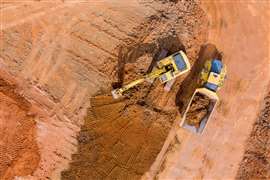Forecast 2024: Still a soft landing for global construction equipment
28 September 2023
OHR: Global slowdown will be a gentle one, and some markets continue to grow
According to specialist forecasting and market research company Off-Highway Research, global construction equipment sales hit a record high in 2021 of almost 1.3 million machines sold. This was across mainstream categories of compact and earthmoving equipment, combined with some machine types in the roadbuilding and off-highway material handling space.
That record volume was driven by the stimulus measures put in place around the world to combat the economic effects of the COVID pandemic. Indeed, it is generally agreed that sales could have been significantly higher were it not for the supply chain constraints and shipping bottlenecks caused by the pandemic.
 Chris Sleight, managing director, Off-Highway Research.
Chris Sleight, managing director, Off-Highway Research.
China was at the forefront of growth in 2021, having put huge stimulus spending in place very quickly in 2020 – an echo of the action it took in 2009 in response to the global financial crisis. For most other countries there was growth – mainly in housebuilding thanks to low interest rates – but it was a slower burn.
The drivers of the previous two years led to a contrasting picture in 2022. In almost all countries of the world apart from China, demand remained red hot. Sales in the world excluding China grew 7% in 2022, following a 19% increase in 2021 in the same territories.
In contrast, the Chinese market had a miserable year. Having boomed due to stimulus spending in 2020 and 2021, sales tumbled 39% in 2022 due to the re-imposition of COVID lockdowns in numerous major cities, along with debt defaults and a general reset in the real estate market. The sharp dip in housebuilding was a particularly heavy blow for the construction equipment sector.
Despite the downturn in China pulling the global equipment market down by 2% overall, 2022 still saw the second highest volume of machinery ever sold.
Outlook: China
At the start of the year, Off-Highway Research expected the global construction equipment market to decline by 7% this year, following the 8% overall decline seen in 2022. The components of that downturn were continued weakness in China combined with a gentler slowdown in other major markets.
The previous expectation for China was that sales would fall 18% in 2023 – a steep drop, but milder than the 39% collapse of 2022. However, the forecast now is for another 40% drop in 2023.
The stimulus spending that was put in place in China in April 2020 burned brightly and briefly for 12 to 18 months. Equipment sales fell off in the second half of 2021, but the first half of the year had been so strong that the market was up as a whole that year. In 2022, not only was equipment demand on the wane, but the country continued to be dogged by major lockdowns and the real estate sector was reeling following the default of the country’s largest developer, Evergrande.
Although there is strong public investment in China, the market is still suffering from weak demand and weak customer buying confidence. The excess of machines available form the boom in 2020 and 2021 is also something of a barrier to new sales.
As with the stimulus of 2020-21, the public spending which is designed to kick-start the market is being funded by provincial government bond issues. Many of these local governments have strained finances, and the reality on the ground is that payments to contractors are delayed and projects are falling behind.
Similarly, in real estate, cash flow is a problem because of the sector’s bad debts and poor credit ratings. There is little appetite to invest in new housing except in the most obviously booming cities.
The only bright area is mining, which is going through a fleet replacement cycle in response to high commodity prices.
 Off-Highway Research forecasts the global construction market in 2024 and beyond.
Off-Highway Research forecasts the global construction market in 2024 and beyond.
Outlook: Europe
Construction equipment sales in Europe rose 4% in 2022, taking sales close to the previous record set in 2007.
Off-Highway Research’s forecast for the region is essentially for the market to stabilize at a high level. Although single-digit percentage annual declines in sales are expected for the next three years, the market is forecast to remain above 200,000 units over the medium term.
A slowdown in housebuilding due to rising interest rates represents a threat to compact equipment sales. However, Europe’s infrastructure markets are strong, which should stimulate sales of larger earthmoving equipment.
Outlook: North America
North America was the pick of the major markets in 2022, with an 8% increase in sales to take demand to a record high of almost 310,000 machines sold.
Although interest rate rises are having a cooling effect on the booming residential market, which drove compact equipment sales in the last two to three years, the shortfall of housing in the region means this sector is still strong.
Sales might see a modest fall this year, but the market will still enjoy the second highest volumes ever seen. An important point is that although equipment volumes might be down, construction in the region is pivoting toward infrastructure, which will drive sales of heavier (higher value) equipment. So, while the number of machines sold might drop, revenues in the segment will rise.
Outlook: India
The most recent high in the Indian construction equipment industry was in 2018. The market was disrupted in 2019 by the general election, which always causes a downturn in sales due to the legal requirement to suspend the award of public works contracts once the election is announced in case this is used as a mechanism to curry undue favor with voters.
The market sank further in 2020 due to the pandemic and only recovered modestly in 2021 as further COVID variants impacted the country. This continued into 2022 to some extent, but more significant was the impact of inflation, which increased equipment prices and adversely affected the financial viability of construction projects. As a result, the market only achieved a modest 2% rise in sales last year.
This year should be better. Broad-based growth is expected to resume, with the market forecast to rise 10%. This will be driven by a range of infrastructure investment plans. With a general election due in 2024, this year’s budget has a particularly strong emphasis on investment as Prime Minister Modi seeks a third term in office.
Unfortunately, the election next year will temporarily derail growth and there will be further market-specific disruption due to the introduction of CEV Stage-V emissions laws in April 2024.
However, Off-Highway Research remains bullish about the medium- and long-term growth prospects in the Indian market, and expects equipment sales to resume their ascent from 2025 onwards.
Outlook: Japan
Equipment sales in Japan fell 4% last year following a strong post-pandemic surge in 2021. As such, the decline is seen as more of a return to normal sales volumes rather than a cyclical downturn. Indeed, the Japanese market tends to be relatively flat and stable, and generally only experiences single-digit percentage changes from year to year.
Having said that, sales in Japan were constrained last year due to component shortages and long lead times for machines. Some of that pent-up demand is expected to spill over into 2023, helping the market to a 2% rise in sales. Thereafter, the market is expected to stabilize at more normal levels of around 63,000 to 65,000 unit sales per year.
Outlook: Rest of the world
Off-Highway Research’s definition of the rest of the world is all countries of the world apart from those specifically named above. Perhaps the biggest positive in 2021 and 2022 was the remarkable growth in this group, which is to say the world’s emerging economies.
The boom in commodity prices was the main driver of equipment sales growth in emerging markets in 2021, with many countries seeing their highest sales since the early 2010s. That boom continued into 2022, leading to record volumes of almost 300,000 units sold in those markets.
The biggest emerging markets tend to be commodity producers; as a result, equipment sales rise and fall depending on demand for materials and pricing. Rising commodity prices give producing companies the confidence to renew or expand their fleets. In many countries, the major producers are state owned, so to some extent high commodity prices are essential for investment in order to balance public finances. By the same arguments, falling commodity prices tend to lead to falls in equipment sales and these cycles tend to be among the more volatile seen around the world.
The forecast for rest of the world markets is based on the premise that the current inflationary pressures globally, exacerbated by the war in Ukraine and its economic repercussions, will keep commodity prices relatively high, but not at the levels seen in 2021 and 2022.
Higher interest rates and slower growth are expected to have a more pronounced impact toward the end of this year, cooling sales, more noticeably in 2024 to 2026.
STAY CONNECTED



Receive the information you need when you need it through our world-leading magazines, newsletters and daily briefings.
CONNECT WITH THE TEAM








